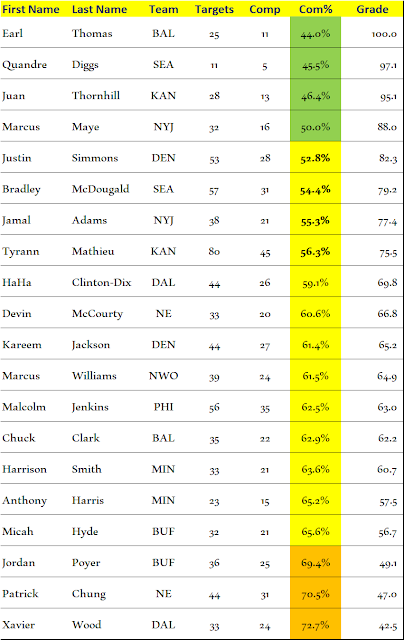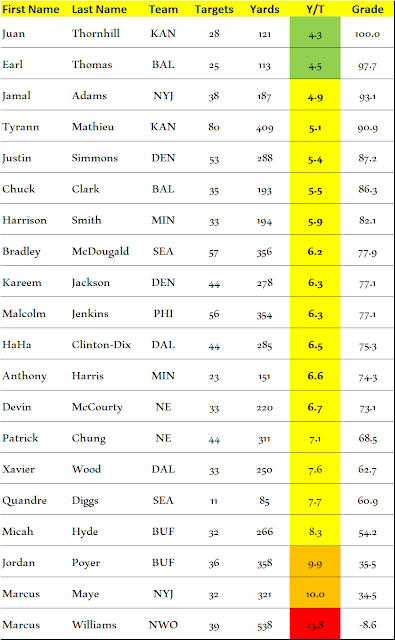While I will not examine Lombardi's claims about Adams' alleged sabotage of his Jets career by asking for fair market compensation compared to his rookie contract, this piece will look at his claim as to why, based on performance alone, Jets GM Joe Douglas would be better off moving on from the All-Pro safety.
I took a look at the safeties listed in the Pro Football Focus article on the top 10 NFL tandems (https://www.pff.com/news/nfl-best-safety-2020-nfl-season-minnesota-vikings-new-england-patriots) and compared the numbers (thanks to www.pro-football-reference.com). Here's what I found out.
Penalties
Lombardi said Adams' game is predicated on the big hit and the intimidation factor it has on receivers. This leads to roughing penalties that will be a huge liability for the team as the league has increased attention to such penalties.
- Over his career Adams has had 4 Unnecessary Roughness/Roughing the Passer penalties. Compared to the players in the PFF piece, for context, when considering the number of defensive snaps he took, he is about in the middle of some notable names.
- It must be considered his 3rd and 4th penalties took place on consecutive plays vs. JAX in 2019. His play is based on reading and reacting, not blowing guys up. Gase properly saw that Adams was too keyed up in the JAX game and sat him down. If Coach had done that a play earlier and Adams had only the one penalty, his rate would have been 1 Roughing Penalty for every 1,035 snaps.
While the raw numbers put Adams near the "questionable" end of the spectrum, considering half of his Roughing penalties occurred on consecutive plays, I would be hesitant to say he's in the Burfict punishment realm. And simply watching his play style is enough to debunk the claim of him being a goon.
Scheme Liability
"Gregg Williams knows Adams... struggles to cover the top receiving tight ends or backs as well as defending the middle of the field when Williams wants to play Cover 2." Lombardi goes on to say, "...but with both Adams and Marcus Maye at Safety, the Jets lack range and playmaking skills when both on the third level. Both safeties have just seven passes defended and one interception apiece last year."
The most remarkable part of the commentary above is the clear miss that, of the key personnel for a Cover 2, Adams and Maye were the two you would most trust in 2019. The necessary physical corners who can jam receivers off the line (squat corners as we called them on my high school team) were not in large supply on the Jets last year. But even more glaringly absent was a top flight MLB who could call out adjustments AND still hustle down field to cover the middle. You think of Derrick Brooks or Brian Urlacher when you think Cover 2 linebackers and no such name was available to NYJ for most of the season. Mosley was solid when healthy but once he got hurt they had no dependable LB. Adams was moved around so much primarily because there was no one of Mosley's ability the team could trust at all three levels of the defense except Jamal.
The most remarkable part of the commentary above is the clear miss that, of the key personnel for a Cover 2, Adams and Maye were the two you would most trust in 2019. The necessary physical corners who can jam receivers off the line (squat corners as we called them on my high school team) were not in large supply on the Jets last year. But even more glaringly absent was a top flight MLB who could call out adjustments AND still hustle down field to cover the middle. You think of Derrick Brooks or Brian Urlacher when you think Cover 2 linebackers and no such name was available to NYJ for most of the season. Mosley was solid when healthy but once he got hurt they had no dependable LB. Adams was moved around so much primarily because there was no one of Mosley's ability the team could trust at all three levels of the defense except Jamal.
Inability to Cover/Lack of Playmaking
Regarding the article's claims against Adams' ability to cover receivers, the good news is the data for opponent completion percentage is readily available. How did Adams do relative to his peer group?
- Of the 20 safeties mentioned in the PFF "Top Safety Duos" piece, Adams was #7 in terms of lowest receiver completion rate (his partner, Maye, ended up third). Each would be one notch higher if we exclude Diggs who's targets were more than one standard deviation beyond the mean.
- Based on the peer group, Adams' completion percentage was within 1 standard deviation above the mean.
- Looks like Adams is in the top 3 of the data group in terms of Yards per Target mapping to a grade of 93.1.
- His Partner in Crime Maye, however, does seem to struggle giving up 10 yards per target.
- It is amazing to see teams kept challenging Mathieu (who was targeted 80 times!) although he is clearly effective with 5.1 Y/T, far better than average.
Air Yards
Adams seems to keep everything in front of him (6.1 air yards) so the numbers don't support him getting beat deep often. He comes in at an above average grade of 81.0 in terms of Air Yards per Completion.
Yards After Catch
Here is where Adams excels giving up only 2.8 yards after the catch which grades out to a 96.9 in the peer group.
Not sure if Marcus Williams had some kind of soft tissue injury last year but his rate was absolutely frightening!
Wrap up
So, when you take all categories and compare Adams to the peer group composed of the top 10 safety duos according to PFF, he ends up as the statistical top safety. Wow...who would have thunk it?
At the end of the day, I could forgive fans once again aligning with the owners in a contract dispute but to somehow say the man is not talented and held back the team? That's just bitter.
**************************************************************
The Fourth Annual All-Social Media Top 100 List for NFL Draft prospects is posted...check it out here! https://boombearfootball.blogspot.com/2020/04/boombearjrs-fourth-annual-all-social_22.html






